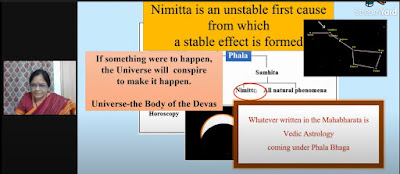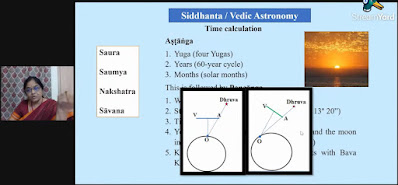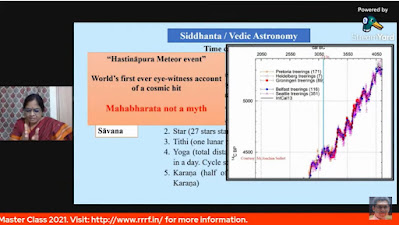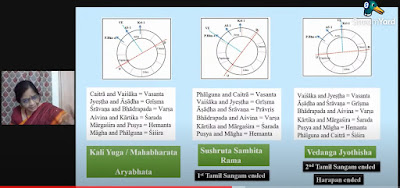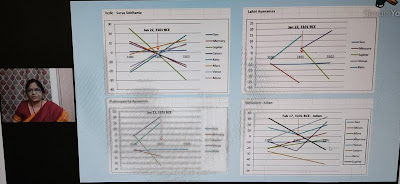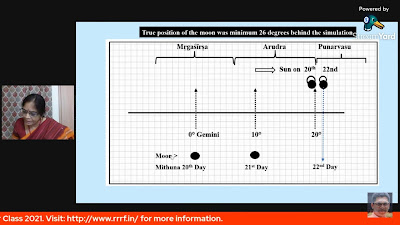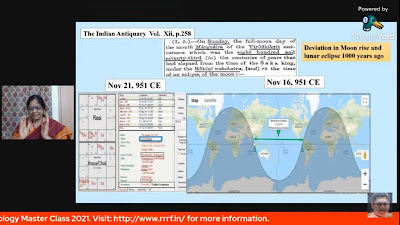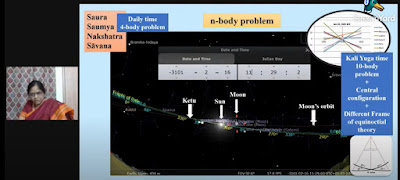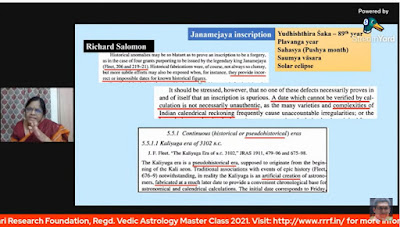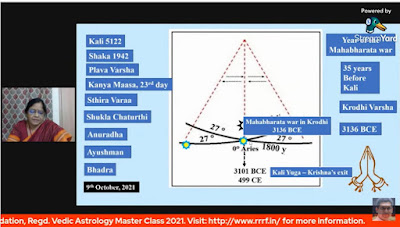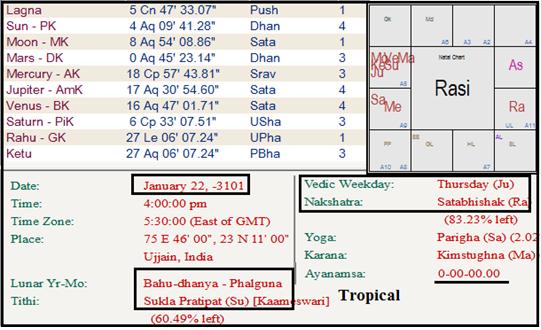Previous
Next
Recap
·
The Catur Maha Yuga is of two types – one, based on the measure of Dharma that passes in
quick succession within a few thousand years and another running into a fixed duration of lakhs
of years.
·
In the Dharma based Yuga, there is no
fixed duration of years for Yuga, Sandhya and Sandhyamsa period. This is not so
in the other type of Yuga.
Chronologically Vaivasvata Manu was the first one to have talked about Catur Maha Yuga classification. This classification is
repeated in the Puranas and Mahabharata. This is purely computation based,
having a fixed duration for each of the Yugas. The date is water-tight that it
cannot be changed at one’s whims and fancies. There exists a test for validating the Kali Yuga begin day. That
will also be taken up in this part to prove
mathematically that the Kali year as maintained till now is absolutely true.
This Yuga system, an ingenious innovation of the
Vedic sages calculates Time at cosmic level. The basic unit is the solar year with the sun
becoming the determinant of time. It crosses approximately one degree of the sky every day giving rise to 360 Savana days.
When the moon is combined
with the sun to determine Time, the phases and the months come into picture.
When the two begin the journey in space from a specific point, they were seen
to come back to the same place on the same phase, tithi and month only once in five
years. That was devised as the 5-year
Yuga and used for ritualistic purposes in the short run.
When the five planets along with the two nodes were
combined with the sun and the moon, the sages found, that it would take 4,32,000 years for all of them to
join together around a same point in space. From this realization was
born the Catur Maha Yuga concept in
long term scale.
The basic requirement for this calculation being the
knowledge of the orbital time of all the nine planets,
it is understood that this calculation could have been made only after the
discovery of all the planets. The Sun and the moon were well known and
well-observed entities in any society. The knowledge of the nodes was already
there in Ramayana. In fact this knowledge must have come from the time man had
started watching the moon’s path from north to south and from south to north
within a month. Of the remaining five planets, Saturn was discovered during Younger Dryas (Part
6) that ended by 11,700 BCE. So the computation of the Catur Maha Yuga must
have been done only after this period.
In this context it is necessary to make a
clarification on some passages referring to a planetary combination at the star
Pushya marking the Kali Yuga and Krita Yuga.
Tishya for Kali Yuga.
In
a dialogue between Sauti and Saunaka
in Mahabharata on a discussion between Brahman and Devas in times of yore,
there appears a description of the four yugas. It starts as follows.
“idaṃ
kṛtayugaṃ nāma kālaḥ śreṣṭhaḥ pravartate”
From
Idam Krita Yugam it is known that
the discussion had happened in Krita
Yuga. Whatever is referenced here can be taken as the earliest. The
description of the Yugas ends with Kali Yuga as follows:
“tatas
tiṣye 'tha saṃprāpte
yuge kalipuraskṛte
ekapādasthito dharmo yatra tatra bhaviṣyati”
Ganguli’s
translation: “(Upon the expiration of Dvapara) the Yuga
that will set in will be called Kali yuga which will come under the influence of Tisya constellation.
Righteousness will lose full three quarters. Only a quarter thereof will exist
in all places.”
The
reference to one part of Dharma in this verse is a clear indicator of the Dharma Yuga cycle.
By
the word “tiṣye’ (locative case) it is conveyed that Kali Yuga would be born at
or in the star Pushya!
This
view seems to be prevalent in Rama’s
times as seen from Malyavan’s reference to
Kali Yuga as Tishya!
This
view continued till the time of Mahabharata war as we see Sanjaya using the name Pushya Yuga in the place of Kali Yuga while
describing the four Yugas.
The
expected birth of a new Yuga, the fourth one with one quarter of Dharma perhaps
gave rise to the concept of Pushya-snana,
of doing austerities on Pushya day to protect oneself (the king) from misfortunes
so that his kingdom and subjects can be protected. (This
practice of bathing continues even today on Full Moon in Pushya in the scared
waters of many temples).
This
view seemed to have altered with time. The relevance of Pushya changed from Kali to Krita Yuga that comes up after Kali Yuga.
Vishnu
Purana states, “When the sun and moon, and the lunar asterism Tishya, and the
planet Jupiter, are in one mansion, the Krita age shall return.”
In
Mahabharata Markandeya is seen telling the Pandavas that Krita age would begin
again when the Sun, the Moon, and Vrihaspati would
be in the same sign with the constellation Pushya.
The
association of just three planets and the birth of Krita following Kali could
be about the Dharma Yuga
and not the Maha Yuga. This reference should not be confused with the
Maha Yuga calculation.
Maha Yuga Calculation.
Conjunction
of all the nine planets is the basic feature of the Maha Yuga. This was pointed
out by Aryabhata as “Gruha sāmānyam Yugam”.
They
congregate at the beginning of Aries every 4,32,000 years. In this
congregation, one of the nodes has to be necessarily outside the group, i.e.
180 degrees away. And that node happens to be Rahu always.
This
congregation takes place 10 times in a Catur Maha Yuga. These recurrences are
apportioned into four Yugas as follows:
Kali
Yuga = 4,32,000 years
Dvapara
Yuga = 8,64,000 years (Two times of Kali Yuga)
Treta
Yuga = 12,96,000 years (Three times of Kali Yuga)
Krita
Yuga = 17,28,000 years (Four times of Kali Yuga)
Total
= 43,20,000 years.
The
naming as Krita, Treta etc., seems to follow just the number system. Kali means one, Dvapara means two, Treta means three
and Krita means four.
The
terms Yugya (yoked) and Yugma (even) are applicable to this Maha Yuga for the
reason that there is an ascending and descending phase for the Yuga. The first
of every Yuga is Utsarpini and the second half
is Apasarpini.
The need for Sandhya period.
The
Sandhya period was attested before and after a Yuga in this system. This is
different from Dharma Yuga Sandhya where a Sandhyamsa was also present. There
is no Sandhyamsa in Maha Yuga as there is no
need to apportion Sandhya (Sandhyamsa means part of Sandhya).Thinking of the
need to have Sandhya for Maha Yugas, only one reason looks plausible. The
planets do not move in a fixed path and in a fixed time. There are bound to be
mild variations. In the long run, there are bound to be unexpected variations
caused by cosmic impacts. So taking all these into account the sages seemed to
have given scope for 10%
deviation of the duration of a Yuga and have added them before and after
the Yuga.
The purport of the Maha Yuga concept
This
calculation can be stretched to any length of time, even before the solar
system was born when the planets were not yet born. The calculation shows that
the sages had made the birth time of the Sun as a basic unit. The sun’s age as
of now is around 5 billion years. That is
roughly close to a day (or night) of the Creator God, the Four-faced Brahma,
calculated as thousand times the duration of the Catur Maha Yuga. It is 4.32 billion years. This is the almost the age of our
Sun as of today.
This
shows our sages had taken the current age of the Sun as the duration of a day of Brahma. The
sun is supposed to have a life time of only 10 billion years, according to
science. Having finished half its life and the sun is going to see a decline in
the thermo nuclear fusion happening in its body. This declining period is the
night time of Brahma. Over all 8.64 billion years make
one day of Brahma (day time + night time).
Thus
the Catur Maha Yuga concept is basically the Vedic way of scientific enumeration of the age of the sun.
The Creator Brahma churns out 36,000 such suns to enable habitable conditions for the sustenance
of life. That idea is enshrined in the Maha Yuga concept. (36,000 is derived by multiplying one year of Brahma by 100. Brahma’s age is 100 years according to scriptures. One year has 360 Savana days. We just deduced that 1 day of Brahma = 1 sun’s life. Therefore 360 x 100 = 36,000 suns.)
The
Sun is a Deva, a palpable deity
in our immediate surroundings and the Yuga concept is a measurement of time
of the Devas. For this reason the duration is given in Divine
years where 1 Divine year = 360 human years (solar years). The following
is the oft repeated version found in the Puranas and Mahabharata. The first and
the third numbers are 10% Sandhya period of the main Yuga given in the middle.
These numbers are in Divine years.
Krita Yuga = 400 + 4000 + 400 = 4,800 (divine years)
Treta Yuga = 300 + 3000 + 300 = 3,600
Dwapara = 200 + 2000 + 200 = 2,400
Kali Yuga = 100 + 1000 + 100 = 1,200
Catur Maha Yuga Total
= 12,000
Converted
into solar years: 12,000 x 360 = 43,20,000 years.
1000
times the Catur Maha Yuga = day / night of Brahma = 432,00,00,000 solar years.
Any
prayer to the Devas must be done in this Time scale of the Devas.
It
is for this reason the Sankalpa mantra
for any work contains the expression of time starting from Deva’s scale to the
lowest at the human level, i.e. the karana of 6 hour
duration.
The
Year name is an important feature of the
Sankalpa mantra. The 60 years originally belonged to the Jupiter cycle with its year beginning at Uttarayana. In the Maha
Yuga system, the year begins at the conjunction point of Aries. The same names are used for the Yuga
years. The 60 year period marks the conjunction of the Dharma-
Karma planets, namely Jupiter and Saturn that lay a foundation for
working out one’s Prarabdha karma.
(That replicates in the descending phase making 120 years the full life of
man). So the names of the 60 year period are crucial for identifying one’s life
time or any event.
There
is a Year name for the start of Kali Yuga. Unless
that is satisfied, there is no point in claiming a year as the first year Kali
Yuga.
With
these basics let me start proving the Kali Yuga date.
Kali Yuga began in the year Pramathi.
In
Kali Yuga system the first year was Pramathi because the planetary conjunction happened at the
beginning of Aries only in that year. The simplest proof comes from Aryabhata’s verse on his age.
He
had written “when sixty times sixty years and three Yuga Pāda-s had elapsed,
twenty three years had then elapsed since my birth.”
(Pāda
in Yuga Pāda doesn’t mean quarter, but just a part. This is reiterated by Vayu
Purana that says “Just as Vedas are divided into four Pādas, a Yuga also has
four Pāda-s” where Pāda means foot. )
Aryabhata
refers to the lapse of 3600 years (60 x 60) since the beginning of Kali Yuga when
he was 23 years of age. At that age the vernal equinox coincided with the
sidereal equinox (zero ayanamsa) according to the commentators, based on the
planetary positions derived from his work. That year was Pramathi! So the first
year of the sixty times of sixty years must have had Pramathi running. In other
words, Kali Yuga started
in the year Pramathi.
Let
me show three simulations from Jhora for the stipulated age of Aryabhata when
there was zero ayanamsa. They are Tropical (used in
astronomy software), Lahiri ayanamsa and Surya Siddhanta (SS) which works on
the limited to and fro equinoctial movement with zero degree Aries as the
center. All of them show Pramathi, but the Sun was not at zero Aries for Lahiri
settings. It was zero for Tropical and Surya Siddhanta though Tropical entry
started seven and a half hours after SS time.
Zero
ayanamsa in SS setting
Comparison of
zero ayanamsa date between Tropical and Lahiri setting.
Pushya
Paksha setting also did not match with zero ayanamsa. The year 499 is not a
simulator creation; the olden commentators had mentioned the same year in Shaka
years, as Salivahana Shaka year 421.
Pramathi
as the first year of Kali Yuga is corroborated epigraphically too. It is a practice to refer to
the first year of the Year cycle in the inscriptions. Most of the inscriptions
found in North India refer to Pramathi as the
start of the counting of years in Kali Yuga. In South India it is Prabhava, the reason being, the year clock was set
back to the first year of the 60-year cycle for counting the years from Kali
Yuga start date. This difference in North – South traditions has no
justification except that North India retained
continuity, while Southern tradition went back to the first year of the
cycle for the New Yuga. When Pramathi was running, it was Prabhava in the South and
this continues till date.
As
such the Tamil inscriptions start as “Prabhavadi
sellaa nindra..” (at the lapse of …. years starting from Prabhava)
An
exception to this is found in the Tamil inscription located in Parameswari Caturvedi Mangalam near
Gingee. It starts as “Pramathi sellaa
nindra..” Expectedly the reigning king mentioned in the inscription was of north Indian
origin. He was Fatenath Singh, the son
of Raghunath Singh, seeming to be
related to Desingh or Tej Singh (Desinghu Raja
in Tamil). The year name (Bhava), Tithi (Shukla Trayodasi) and star
(Uttarabhadra pada) perfectly match with the year 1754
– for which there is no historical record of Desingh’s descendants ruling from
Gingee. Only this inscription stands as an evidence for an unknown history of the
north Indian dynasty ruling this part of South India around 1754. Additionally
this inscription offers credence to the north- Indian tradition of the Era beginning with Pramathi.
There
are few other inscriptions giving the Kali Year along with the shaka year or
the regnal year of the king, offering scope to cross check. They all point out
to the beginning of Kali Yuga 3101 years before the Common Era. The
inscriptions in Salivahana
Shaka years also point out to the same beginning at 3101 BCE. Epigraphy
offers a robust validation for the date of the Kali Yuga.
The first year of Kali Yuga
Pramathi
was the first year of Kali Yuga derived from Aryabhatiya and also from the
continuing record of the Kali year in the Pancangas. All the planets except
Rahu were together at the beginning of Aries at that time.
This
was never questioned by the Hindus until the westerners studied our system and
handed out their ‘expert’ comments. In their inability to derive the conjunction
from the Julian period they had used, they rejected the Kali Yuga computation
as a fabricated one. Starting from them, this trend of rejecting the Kali Yuga
date had continued till date, for the most obvious reason of the mismatch between the planetary - calendar system of the astronomy
simulator and the Vedic system of computation. Now let me show the simulated version for the
Kali date conjunction from Tropical setting (used in
astronomy simulator), Lahiri, Pushya paksha and Surya Siddhanta setting.
Let
me begin from the Surya Siddhanta setting.
The
Year is Pramathi, Caitra, Thursday, the sun and the moon at Aswini, the sun
having just entered Aries and all the planets except Rahu at the beginning of
Aries within 2 degree distance. Mars is at the 7th degree from the
beginning of Aries. Following this conjunction, the first day of Kali Yuga
started on the next day, i.e. Friday. Surya Siddhanta setting offers excellent corroboration of
the Kali Yuga conjunction and the associated Pancanga dates.
Tropical setting for the same date and time.
Major
differences are seen in Tropical setting. The year has changed to Bahu-dhanya. The Star is different. The planetary
conjunction is seen but at the beginning of Aquarius, and the month is Phalguna. Abhyankar’s simulation is close to this. The vernal equinox for this year was shown at mid-Taurus, not at the beginning of Aries, as seen in SS setting. The inference is that the Tropical zodiac is unsuitable to date Kali Yuga (and therefore
Mahabharata war that took place 35 years before Kali Yuga started).
Lahiri setting for the same date and time.
The
Year and week day were the same, but the tithi had advanced. More than anything,
the sun and the moon were in Pisces with the sun, 10 degrees behind the zero
degree mark of Aries. Saturn was also far away. The ayanamsa value shows the Vernal equinox in Taurus. The Kali Yuga conjunction that
is possible in Surya Siddhanta setting is not showing up for Lahiri setting.
Pushya paksha setting for the same date and time.
Pushya
Paksha differs from Lahiri by 1 to 2 degrees. We can see only the year and the week day matching. The Sun was at 22 degrees Pisces, so too was the moon.
Saturn was far behind. Ayanamsa value shows the vernal equinox occurring in Taurus. There is complete mismatch with the Kali Yuga pointers.
One
can try for any other year in Lahiri, Pushya paksha, Tropical or any other
ayanamsa. Pramathi repeating only once in 60 years,
it is not possible to get the conjunction for any other year. The discovery of
the conjunction of all planets at zero Aries is a rare gem of importance to astronomy, precession theory and orbital physics.
The
combination appearing only for the SS setting is proof of the reliability of the calculations that
have gone into making the settings. While this could work perfectly for zero
ayanamsa that needs no correction to the planetary degrees, the same cannot be
assured for times of vernal equinox farther away from zero Aries, obviously
because the rate of change of ayanamsa is not constant.
Compare
this with the date of 3067 BCE promoters who claim that Kali Yuga started on
the year of the war when Bhima killed Duryodhana. For their year 3066 BCE in
Julian setting, the year was Ananda!. What an
irony of sorts that the fierce war was fought on a year that was supposed to bring
Ananda! The names were not arbitrarily given. The names carry the nature of the
years. A war of the scale of Mahabharata had taken place in Krodhi and not Ananda.
Alternatively
the 3067 backers prefer to de-link Kali Yuga. That is demonstrative of the complete
absence knowledge of the historical connection between the Kali date and the exit of Krishna and the year of the war. If every scriptural reference to this
historical connection told by none other than the sages are junked by these
researches, what else is the basis for these researches?
Mathematical proof for the Kali Year.
The
week day is the
test for the reliability of the Kali date.
The
conjunction of all the planets happened on a Thursday,
as told by Aryabhata. The next day the counting of the Kali day started. In
other words, the first week day of the Kali Yuga was a Friday.
The week day count continues uninterruptedly for all ages. Starting from Friday
on the first day of Kali Yuga, the continuity of the week day must be
maintained till date. Compare this with the Julian calendar where 10 week days
were compromised.
In
any calculation of a particular day in the Kali Era, the total number of Kali days are divided by 7. If the reminder is zero, the day is
Thursday. If the remainder is 1, it is Friday, if 2 it is Saturday and so on. The
formulae given for writing Pancangas also end up with the same version that the
counting started from Friday.
As
a sample calculation let us take up the days of the sidereal year. The Sun’s
movement from Asvini to Asvini forms a sidereal year. It has 365 days and a few
hours. Divide 365 by 7. The remainder is 1. Therefore the first day of the next
year is Friday. This is how the enumeration of the week day goes, but this
cannot be as simplistic as this, for there are hours and minutes left. They
pile up in such a way that the day advances by one
every 5th year. The following table shows the advancement in
Vedic day and calendar day at the beginning of every year (sidereal).
Table 1
The
Kali Year with its corresponding CE year is given on the left. The solar
ingress into Aries is given in the 4th column. This data is taken from Jhora astrology simulator. This data is
important due to the reason the Vedic day starts at sunrise whereas the
Calendar day (Gregorian) starts at mid night before sunrise. So, for the same solar ingress time, the next calendar day would start if the ingress time is after mid-night. For that time the Vedic day would continue to be the previous day. You will find this mismatch in the Vedic and calendar days in the Table.
The progression of time can be seen to follow a specific time gap of six hours in the Table. Actually the days are April 14th or 15th for these years of the current period. 365 days + 6 hours are solidly added every year. The 6 hour period is seen to move up and down within 14th and 15th April at present.
The week day on
the first day of each year progresses continuously for four years and skips one
day on the fifth year due to shift between two dates. In the Gregorian calendar the adjustment is done deliberately by adding one day for the non-counting of 6 hours in every year. In the Vedic calendar the adjustment happens automatically as it sticks to the ingress time during the day. When the ingress occurs at evening or night, that day is not taken as the first day, instead the next day is treated as the first day. In this way one day is skipped from becoming the first week day of the year. This goes on forever. This element is added in the Table below. I named it as Ritual day, for, only this day is recognized as Vishu and fit for Sankramana Tarpana.
Table 2
The
Ritual day is added
as the first column. It can be seen the skipped days do not match with the Vedic day.
The Vedic day takes in to account just the sun rise
time, but the first day of the year follows the solar ingress time. Look
at the 3rd row. The solar ingress happened at 7 PM on a Friday. This
was skipped and instead the next day (Saturday) was taken as the first day of
the year. The highlighted days in the first column can be checked with the 5th
column (solar ingress) to know which day gets skipped
and how the day progresses.
This
can be cross-checked mathematically. In other words, the mathematical test for the start of the Kali Yuga time lies with the sequence of the week days on the first day of any Kali Year. The first day of the Yuga started on a Friday. Now after 5122 years, the sequence of week days after skipping every 5th week day must have continued and be matched with the running week day of the present times.
For computing we need the length of the sidereal day. This is given in various texts as follows, but they are
not reliable for the current times.
I
am taking the most recently available figure from “Veemanatha
Pancanga Vākya” (Tamil), written in Kali Year 4968, corresponding to
1867 CE.
The length of the year given in this Tamil text is 365 days, 15 Nazhigai (नाडी), 31 Vinadi and 15 Tatparai.
The
conversion is given below. The last column is in Tatparai
From
Nazhigai to clock time, the conversion is this:
1
Nazhigai = 24 minutes.
From
this the duration of a day and the Vedic Year can be calculated.
The
Vedic year = 365.2586806 days
At
present = 365. 256363 days
There
is a difference of 0.002317552 days showing that the sidereal year at present is shorter than it was in 1867CE. This means the earth completes the
revolution faster than it was in the year 1867 CE. The year ends 3.33727488 minutes earlier. This is the revelation not known to the scientific community.
The
duration of the year is converted into the lowest denomination, i.e. tatparai.
1
year = 365 days, 15 Nazhig, 31 vinadi, 15 tatparai
1
year = 78895875 tatparai.
This
is to be added every year to arrive at the length of the year.
Basically to know the number of elapsed days in Kali Yuga, the Kali year that ended is multiplied by the length of a year given in tataparai. This is converted into days and divided
by 7, to get the week day on the first day of next year.
The
calculation is produced below for seven years starting from 2015 to 2021. We have to check if the sequence of the week days appear in this calculation to establish the authenticity of Kali Yuga year.
The top row gives the completed Kali Years. The second row gives the corresponding CE year when the Kali year ends and the new Kali year begins. (The Kali year begins at Mesha sankramana)
The
third row shows the length of a sidereal year in Tatparai.
The fourth row (tatparai) shows the elapsed Kali days in Tatparai as at the end of the Kali year mentioned in the first row. This is obtained by multiplying the elapsed Kali years by the tatparai duration of a year. For example for the year 2015 CE, the Kali year 5116 multiplied by tatparai of a year is entered in the fourth row.
The 5th row converts this duration into days.
The 6th row gives the result of the days divided by 7.
The 7th row notes down the decimal part of the remainder.
The 8th row shows the remainder converted into days.
The 9th row converts the decimal of the remainder into Nazhigai. The 10th and 11th rows show the corresponding Nazhigai into minutes and hours.
Let us take the second
column showing the number of Kali days on the first day of Citra in 2015 CE
corresponding to Kali year 5116. When divided by 7, the remainder is 5.6 days.
Counting from Friday, it is Tuesday.
The next column shows the next year details. In the next year (Kali 5117 / 2016 CE) the remainder is
zero. So that year started on Thursday.
As the day progresses like this, the Nazhigai also gets added. By the beginning of the year 2020 CE (Kali year 5121), the remaining day becomes 4.9 in which 4 is Monday (counted from Friday). The decimal place corresponds to 54 Nazhigai or 21.6 hours. Being closer to almost a full day, the next day is taken as the first day. It is Tuesday. Thus from 2019 CE to 2020 CE, the first week day jumps from Sunday to Tuesday. This can
be cross checked with Table 2 for the time of solar ingress in the year 2020 CE. The time was 8 PM on Monday. The rituals cannot be done on that day, but only in the next day after sunrise. Therefore Tuesday becomes the first week day in 2020 CE. This adjustment happens automatically in the calculation.
The inference is that the Kali Year and the
first week day of the Kali year have a fixed relationship. From the 1st
day of Kali Yuga that started on a Friday, this continuity is maintained in
such a way that every 5th year the week day advances. What is seen
presently in our calendar and picked out from the simulator tallies with the
mathematically arrived remainder of the Kali days of the year.
If you change the Kali Year, the number of Kali days change and the
week day also changes. The current week day can remain as it is only if the true Kali date is not changed. This unchanging sequence helped the
Siddhantins such as Aryabhata to say emphatically that Kali Yuga conjunction
happened on a Thursday 3600 years before his time when he was 23 years old. To
ignore this knowledge and impose another date as Kali year is cultural genocide imposed on the uninformed people of Bharatavarsha. Not only that, the scientific system of this country is also being buried by mass ignorance.
This
kind of counting is not possible for Mahabharata war day
that 3067 backers are proposing as the time Kali Yuga began. You need to
know the extent of a year; you need to know the first week day of the year. That first day should have some
cosmic relevance – like the solar ingress. Where
are all these for the day of “Praptam Kali
Yugam” time? Dating Mahabharata is not a child’s play – but it’s being done
as a child’s play with a simulator in one hand and fanciful thoughts on the other.
In the process, only our Sanatan knowledge is getting sidelined to be forgotten forever.
This
discourse continues for few more parts, to remove the cobwebs woven around Shaka
years and the Aihole inscription.
(To
be continued)










